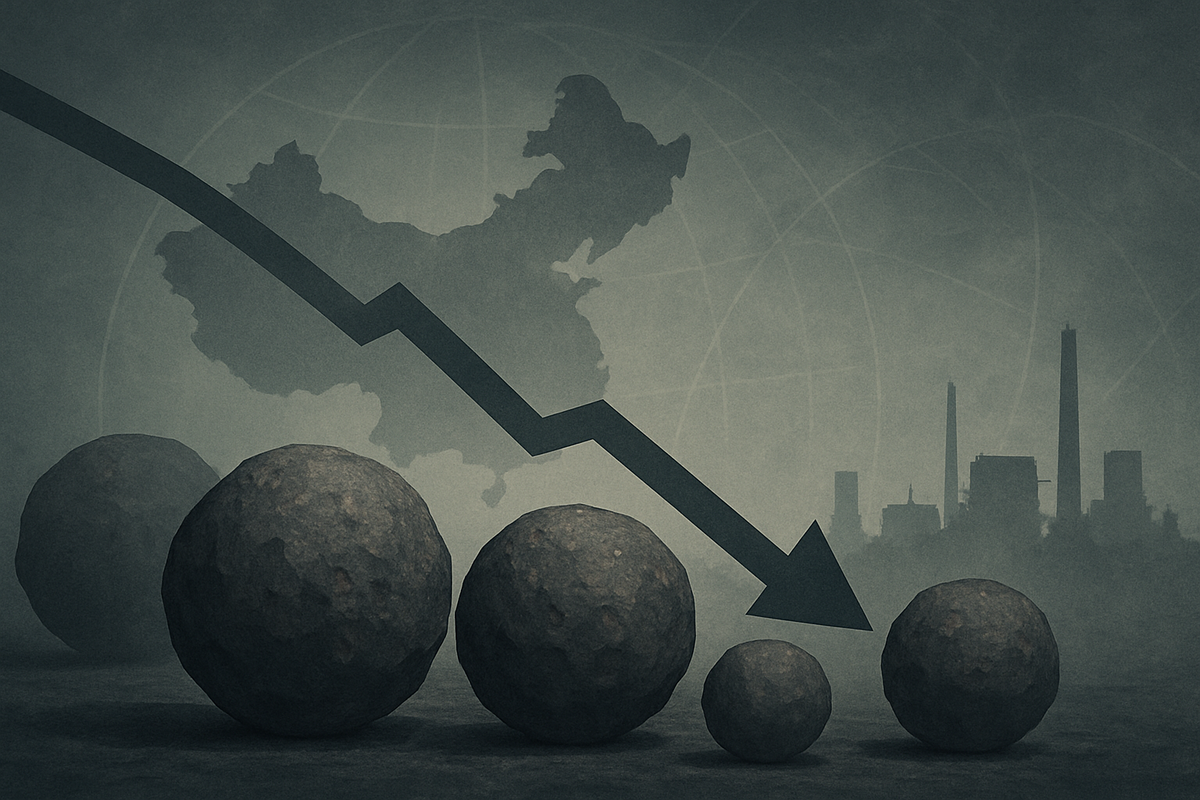
The global iron ore market faced significant headwinds in late 2024, as persistent demand concerns from China, the world's largest consumer, exerted considerable pressure on prices and market sentiment. This period was characterized by declining prices, elevated inventories, and a cautious outlook on China's economic recovery, sending immediate ripples through global commodity discussions. From the vantage point of November 2025, these events are understood not as mere cyclical adjustments but as a critical juncture, highlighting deeper, more structural transformations within the global steel and mining industries.
The downturn in late 2024 served as a stark reminder of China's pivotal, yet increasingly complex, role in global commodity markets. The struggles within China's property sector, coupled with broader economic rebalancing efforts, created a challenging environment for iron ore producers worldwide. The implications extended beyond immediate price movements, signaling a fundamental shift in market dynamics and prompting a reassessment of long-term strategies across the industry.
Detailed Market Turmoil and Key Influences in Late 2024
The iron ore market in late 2024 experienced considerable strain, marked by a confluence of factors including declining prices, surging inventories in China, and a weakening demand predominantly driven by China's struggling property sector. This period witnessed a notable shift in market dynamics, leading to widespread production cuts in the steel industry and a cautious outlook among key stakeholders.
Iron ore prices trended lower for much of 2024, with late 2024 showing continued weakness despite some temporary rebounds. The Platts Iron Ore Index (IODEX) averaged $99.7/dry metric ton (dmt) CFR North China in Q3 2024, falling 10.85% quarter-on-quarter and reaching a 23-month low of $89.35/dmt on September 23. By December 2024, iron ore futures had ended the year with a drastic decline of more than 15%. The most-traded May iron ore contract on China's Dalian Commodity Exchange (DCE) closed at 779 yuan ($106.73) per metric ton on December 31, 2024, having fallen 16% year-to-date. Similarly, the benchmark February iron ore on the Singapore Exchange (SGX) was at $100.4 a ton, marking an 18.5% slide year-to-date. Goldman Sachs had even revised down their Q4 2024 iron ore price forecast to $85/mt from an earlier average of $100/mt due to global oversupply and lower demand from China.
Compounding the price pressure, Chinese port inventories of iron ore accumulated significantly. By the end of December 2024, inventories at Chinese ports rose by 28% year-on-year to 146.85 million tons. Earlier, as of August 29, 2024, imported iron ore stockpiles at China's 45 largest ports had surged to 153.7 million tons, the highest level since April 2022. This surge was attributed to increased vessel cargo unloading and slower ore outflows to end-users, creating a paradox where reduced global shipments failed to prevent inventory buildup.
The primary driver of this market pressure was the persistent weakness in China's property sector, which accounts for an estimated 30-40% of the country's steel demand. New home starts continued to fall sharply, down 22% in the year to September 2024. Chinese crude steel output also fell by 2.7% year-on-year in the first 11 months of 2024. While Beijing introduced various stimulus measures in late 2024, including policy rate cuts and eased mortgage rules, their effect on underlying iron ore demand was largely temporary and insufficient, focusing more on clearing existing property inventories rather than stimulating new construction. Environmental regulations, such as production controls in the Tangshan steel hub and the impending inclusion of the steel sector in China's Emissions Trading Scheme, also influenced output and demand.
Key players and stakeholders profoundly affected included major iron ore miners such as Vale (BM&FBOVESPA: VALE3), Rio Tinto (ASX: RIO, LSE: RIO), BHP (ASX: BHP, LSE: BHP), and Fortescue Metals Group (ASX: FMG), alongside major Chinese steel producers like China Baowu Steel Group and Ansteel Group Corporation. Initial market reactions were largely characterized by caution, with steel producers implementing widespread production cuts due to margin compression, and miners focusing on cost management and operational efficiency to navigate the challenging landscape. Financial institutions consistently revised down their iron ore price forecasts, highlighting the severity of the demand-side issues.
Corporate Fortunes in a Tumultuous Market
The iron ore market pressure in late 2024, driven by China's faltering demand, created distinct winners and losers among public companies, largely depending on their reliance on iron ore, cost structures, and diversification strategies. Major iron ore producers generally faced significant headwinds, while steel manufacturers navigated a complex scenario where lower input costs were often offset by weak steel demand.
Vale S.A. (BM&FBOVESPA: VALE3), as one of the world's largest iron ore suppliers, was highly vulnerable, with iron ore accounting for approximately 80% of its revenue. The company shed over $17 billion in market value in 2024, and its stock price plummeted to its lowest point since 2020. Vale's Proforma EBITDA for 2024 declined by 22% year-on-year. Despite solid operational performance in Q4 2024, Vale optimized its portfolio towards higher-margin products and aimed to boost its copper and nickel production to diversify revenue streams. By Q3 2025, Vale reported robust sales performance across all business segments, with average realized iron ore fines prices increasing.
BHP Group (ASX: BHP, LSE: BHP) reported its lowest annual underlying profit in five years for fiscal year 2025 (ending June 30, 2025), a 26% decline to $10.16 billion, largely attributed to a 19% fall in average iron ore prices. BHP shares experienced pressure in late 2024 and early 2025 due to rumors of China halting purchases and ongoing pricing disputes. However, by October 2025, BHP's stock showed resilience, posting gains of 5.2% in the last 30 days and 7.9% year-to-date, indicating a market rebound. The company aimed to increase its iron ore output and diversified into copper assets to offset pressure on iron ore earnings.
Fortescue Metals Group (ASX: FMG) had a challenging 2024, with its share price falling by more than 33% by December. For fiscal year 2025, Fortescue reported a significant 41% decline in annual profit to $3.37 billion, its lowest in six years. However, Fortescue's shares showed a remarkable turnaround by October 2025, climbing 37% since June 2024, fueled by improved iron ore market conditions. The company pursued a dual-focused strategy: enhancing productivity in its traditional mining operations and accelerating investments in its green metals division.
Rio Tinto (ASX: RIO, LSE: RIO), another major mining giant, was also affected by falling iron ore prices. Its Simandou iron ore project in Guinea is on track to deliver first production in late 2025, which is expected to further pressure iron ore prices in 2026 due to the substantial new supply entering the market.
Among steel manufacturers, ArcelorMittal S.A. (NYSE: MT) demonstrated remarkable resilience. Its Q4 2024 results showed narrowed losses compared to Q4 2023, and Q1 2025 core profit was above market expectations, partly due to strong performance in its Liberian iron ore mining segment. ArcelorMittal's stock experienced a "47.85% rally in 2024" and continued strong movement into 2025, hitting a 52-week high around October 2025. This positive performance was attributed to a rebound in key industrial sectors, strategic geographical positioning, and proactive corporate initiatives, including investments in "green steel" production.
In contrast, POSCO Holdings Inc. (KRX: 005490) reported a decline in sales and operating income for the first three quarters of 2024, largely due to the downturn in China's real estate sector. Its stock price collapsed by 60% from its 2023 high by September 2025. POSCO focused on diversifying into its Rechargeable Battery Materials business and expanding its Infrastructure business, anticipating production restoration and lower input costs in Q3 2025.
Broader Implications and Historical Parallels
The iron ore market pressure in late 2024, stemming from China's demand concerns, was not an isolated event but a clear indicator of profound, ongoing transformations. From the perspective of November 2025, it represented an acceleration of trends towards a more diversified, decarbonized, and potentially less volatile, albeit lower-priced, iron ore market.
This event fits into several broader industry trends. Firstly, China's economic rebalancing suggests a plateau or decline in its steel demand, moving away from steel-intensive industrial sectors towards services. This structural shift, particularly the prolonged property market crisis, is a primary driver of demand weakness. Secondly, a global oversupply is evident, as major producers continue high production while inventories at Chinese ports surge. The impending new supply from projects like Simandou in Guinea is expected to exacerbate this oversupply. Thirdly, the global push towards decarbonization and "green steel" production, involving electric arc furnaces (EAFs) and direct reduced iron (DRI) technologies, implies a potential reduction in overall virgin iron ore demand, though it might create premium markets for higher-grade ores.
The ripple effects were significant. Iron ore exporting nations like Australia and Brazil faced material impacts on their economies, with analysts anticipating continued slowdowns in China to weigh on their share markets. While Australian export volumes were forecast to rise, earnings were expected to decline due to lower prices. Global steel producers outside China faced challenges from robust Chinese steel exports, though anticipated "supply side reform 2.0" in China's steel industry could eventually benefit international producers. A severe downturn in iron ore prices also risked triggering a broader downturn in other commodity markets, hurting resource-dependent economies.
Regulatory and policy implications were also notable. Beijing's stimulus measures in late 2024 aimed to spur the economy, but their effectiveness in the property sector was limited. China's Emissions Trading Scheme was expected to include the steel sector, potentially leading to output curbs. The establishment of the China Minerals Resources Group (CMRG) in 2022 centralized procurement, giving China more leverage in negotiations. Internationally, growing resource nationalism and trade protectionism, exemplified by potential US tariffs on Chinese imports and EU anti-dumping measures on Chinese steel, influenced global trade flows and pricing.
Historically, the iron ore market has experienced volatility tied to China's economic cycles, such as the Global Financial Crisis in 2008 and the 2015 downturn driven by oversupply. However, the late 2024 pressure was seen by many analysts as a "structural" challenge rather than purely cyclical, suggesting a more prolonged period of adjustment. The long-term implications, already apparent by November 2025, include sustained price pressure, increased focus on diversification and cost efficiency for miners, accelerated green steel transition, and a shifting global steel production landscape. Paradoxically, some analyses in 2025 noted a decrease in iron ore price volatility since mid-2024, attributed to changes in Chinese buying behavior and a more balanced market fundamental.
The Road Ahead: Navigating a Transformed Market
The iron ore market is navigating a complex and transformative period following the significant demand concerns from China in late 2024. As of November 2025, the industry faces persistent downward pressure on prices due to an anticipated oversupply and a structural shift in China's economy. However, emerging markets and the global push for decarbonization present new opportunities and necessitate strategic adaptations from market players.
In the short term (November 2025 - 2026), the iron ore market is expected to remain under pressure due to subdued demand from China and a mild global surplus, which is projected to become more significant in 2026 and 2027 with new supply coming online, notably from the Simandou project in Guinea. Price projections from various institutions, including UBS and Goldman Sachs, anticipate averages around $95-$100 per ton for 2025, with further declines into 2026 and 2027. China's steel demand stagnation, driven by the property sector crisis and efforts to address overcapacity, remains a primary factor.
Looking long-term (beyond 2027), the outlook points to a multi-year downtrend in iron ore prices, with some forecasts seeing averages as low as $78 per ton by 2033. Wood Mackenzie forecasts Chinese steel demand to decline by 5-7 million tons annually over the next decade. A significant trend is the global push for steel decarbonization, favoring higher-grade iron ore for cleaner technologies like electric arc furnaces (EAFs) and hydrogen-based direct reduced iron (DRI) processes. This will likely lead to growing premiums for high-quality lump and pellets, while prices for low-grade ore could fall significantly.
These evolving market dynamics demand significant strategic adjustments. Major mining companies must prioritize cost discipline, portfolio diversification into critical minerals, and value-added growth by focusing on higher-grade ore. They also need to diversify market reach beyond China and navigate the shifting power dynamics with entities like the China Mineral Resources Group. Steel producers, especially in China, need to diversify output, invest in low-carbon technologies, and adapt raw material sourcing to meet decarbonization mandates. Traders and investors must maintain market agility, closely monitoring grade preferences, price trends, and policy developments, and target investments in high-grade ore producers and green steel technologies.
Emerging market opportunities, particularly in India and Southeast Asia, are expected to exhibit robust growth in steel production and iron ore consumption, driven by urbanization and infrastructure plans. The global decarbonization push also creates strong opportunities for producers of high-grade iron ore. However, challenges include the insufficient scale of these emerging markets to fully offset Chinese demand in the near term, their reliance on domestic supply, and the complexities of developing new supply chain infrastructure. Geopolitical and trade tensions, such as the ongoing US-China trade war and potential tariffs, also continue to influence global commodity flows.
Several potential scenarios and outcomes for the industry emerge: a prolonged oversupply and lower prices, a two-tiered market with premium pricing for high-grade ore, increased market volatility influenced by geopolitical factors, accelerated industry transformation towards sustainable practices, and shifting power dynamics with increased influence from Chinese steel mills.
Comprehensive Wrap-up and Investor Outlook
The iron ore market has entered a period defined by structural adjustments rather than just cyclical swings. The pressures of late 2024, rooted in China's demand concerns, were not merely temporary fluctuations but represented a profound structural shift in the iron ore market. The prolonged weakness in China's property sector indicates a fundamental rebalancing of its economy away from infrastructure-heavy growth, which will have a lasting impact on global steel and iron ore demand.
The significance lies in the decoupling of China's historical role as the primary demand engine from a singular growth trajectory. While China will remain a dominant force, its domestic demand is expected to plateau or even decline over the next decade. This necessitates a global reallocation of supply and a greater focus on emerging markets. The rise of resource nationalism and environmental mandates also introduces new complexities, reshaping production, trade, and investment strategies.
Moving forward, the market outlook through November 2025 and beyond indicates continued headwinds from a rebalancing Chinese economy and increasing global supply. Investors must maintain vigilance over these multifaceted factors to navigate what is expected to be a volatile and challenging market environment.
Investors should closely watch for:
- China's Property Market and Stimulus Effectiveness: The health of China's property sector remains paramount. Any concrete and effective fiscal measures from the Chinese government could provide temporary support, but a long-term decline is anticipated.
- Global Steel Production and Demand Outside China: Monitor steel production growth in other regions, particularly India and Southeast Asia, as these markets are expected to drive future demand.
- Iron Ore Supply Dynamics: The ramp-up of new, significant iron ore projects, such as Rio Tinto's (ASX: RIO, LSE: RIO) Simandou mine, will add substantial new supply and could further pressure prices.
- Trade Tensions and Protectionism: Geopolitical factors and potential tariffs could impact trade dynamics and Chinese steel exports, indirectly affecting iron ore demand.
- Inventory Levels at Chinese Ports: Sustained high levels of inventory could signal ongoing demand weakness and downward price pressure.
- Green Steel Adoption: The pace of adoption of green steel production initiatives globally will influence long-term demand for traditional iron ore, potentially favoring high-grade ores while reducing overall volume demand.
- Currency Fluctuations: The strength of the Chinese yuan can influence iron ore prices, as a stronger yuan can make imports cheaper for Chinese buyers.
This content is intended for informational purposes only and is not financial advice





